Peperomias are popular houseplants because they are hardy plants and require little maintenance. Peperomias, which describes plants belonging to a genus comprised of over 1,000 tropical plants, vary widely in appearance. Many of these plants are sold as houseplants. This blog post is a list of some of my favorite Peperomias that can be kept as houseplants.
1. Emerald Radiator Plant (Peperomia caperata ‘Rosso’)
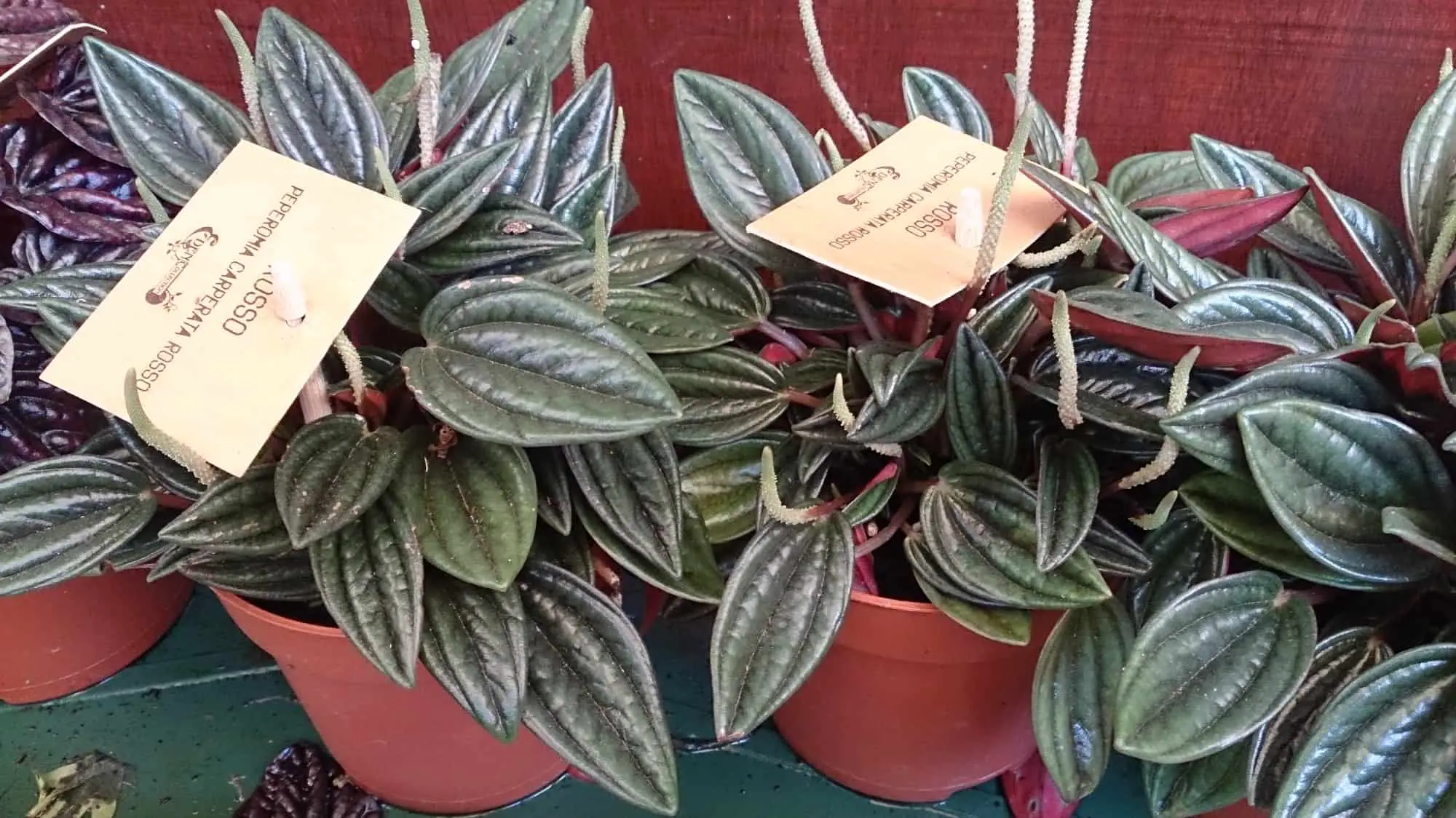
Peperomia caperta ‘Rosso,’ which is commonly referred to as Radiator Plant or Emerald Radiator Plant, is one of the most common Peperomias on this list. It is probably my favorite Peperomia because it does not require much care, and it looks great all year. Although these plants will not grow well in dark settings, they can be successfully grown in fluorescent lighting. It is important to avoid overwatering this variety of Peperomia. However, you should not allow the soil to dry out completely between waterings. Allow the top one to two inches to dry out between watering sessions.
2. Watermelon Peperomia (Peperomia argyreia)
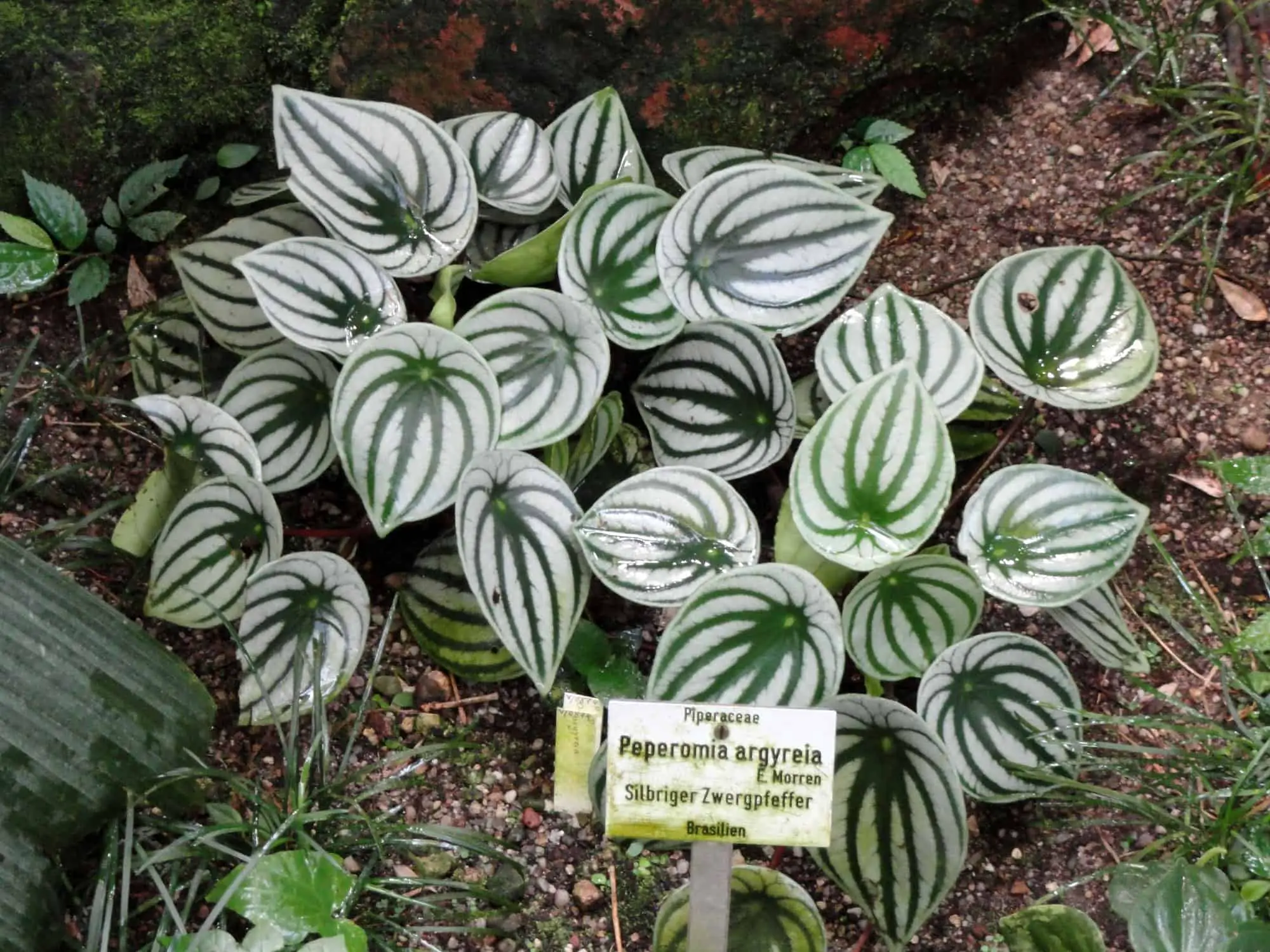
Peperomia argyreia is commonly referred to as Watermelon Peperomia because the leaves look like watermelons. Although the leaves look like watermelons, Watermelon Peperomia is not related to watermelon. The plant is native to South America and makes an excellent houseplant for new plant parents. These plants will grow best when placed a few feet away from an east or west-facing window. Like other Peperomias, it is important to allow the top 1-2 inches of soil to dry out between watering sessions.
3. Rainbow Peperomia (Peperomia clusiifolia)
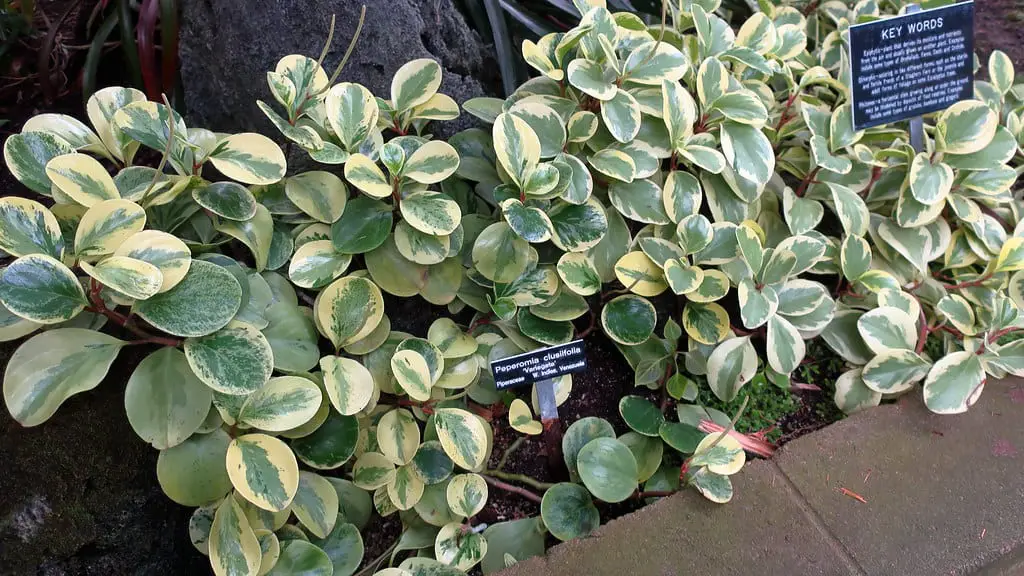
Peperomia clusiifolia, which is commonly known as Rainbow Peperomia or Jellie Plant, is a succulent native to Southern Florida and Central America. Its distinctive red edges make it a great addition to any plant collection. This plant can be grown in a wide range of environments. For example, it can tolerate low-light conditions, but the colors will not be as vibrant. Rainbow Peperomia can also be grown outdoors in USDA Hardiness Zones 10 through 12. Although Rainbow Peperomia can adapt to many environments, it does not tolerate cold temperatures (<50°F) very well. Avoid placing this plant next to drafty doors and windows.
4. Peperomia Perciliata (Peperomia perciliata)
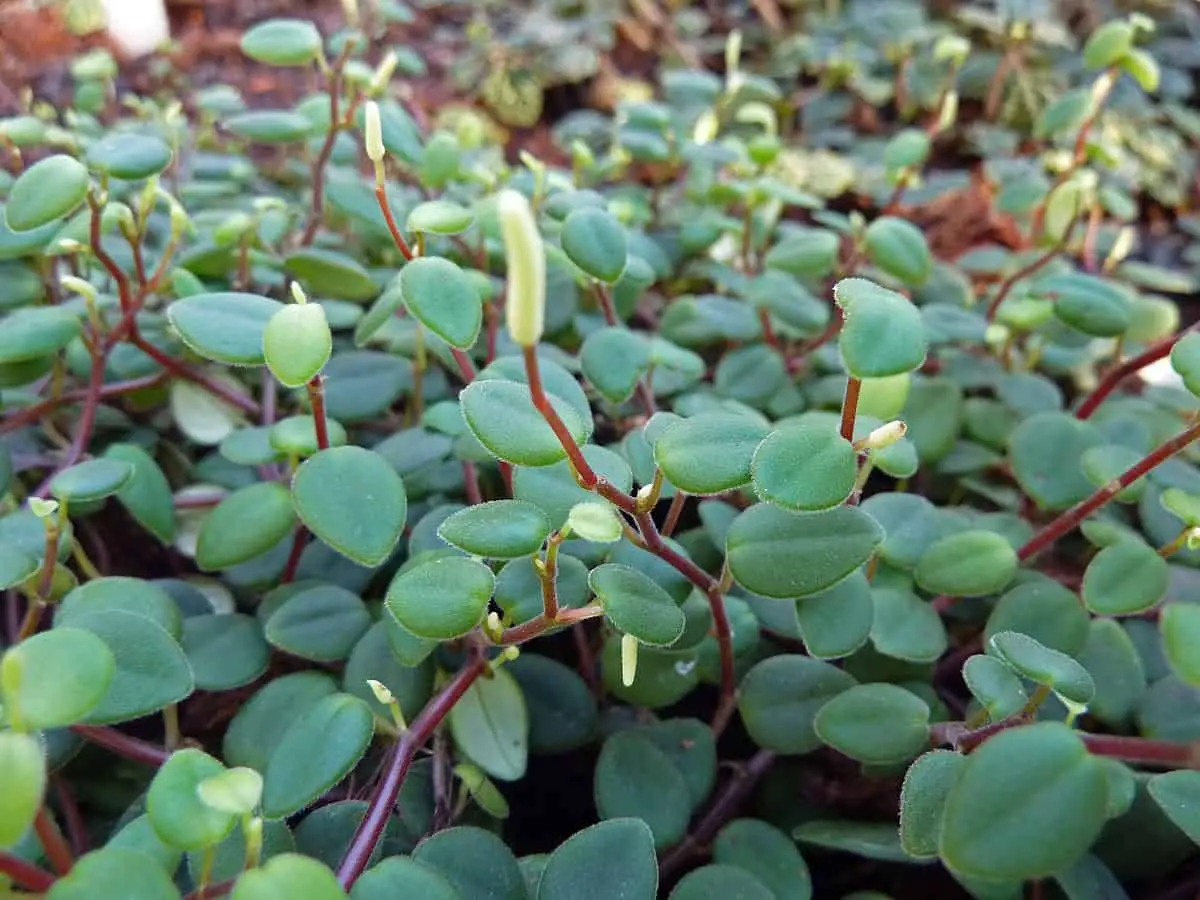
Peperomia perciliata, which is also called Peperomia fagerlindii, is a rare find and is not commonly sold in nurseries or big box stores. Unfortunately, this plant is endangered in its natural habitat (Panama and Columbia). If you do manage to get your hands on one of these plants, it is best to place it directly in front of a window (ideally eastern or western exposure). Peperomia perciliata also makes a great addition to terrariums since it is a low-growing plant.
5. Columbian Peperomia (Peperomia metallica)
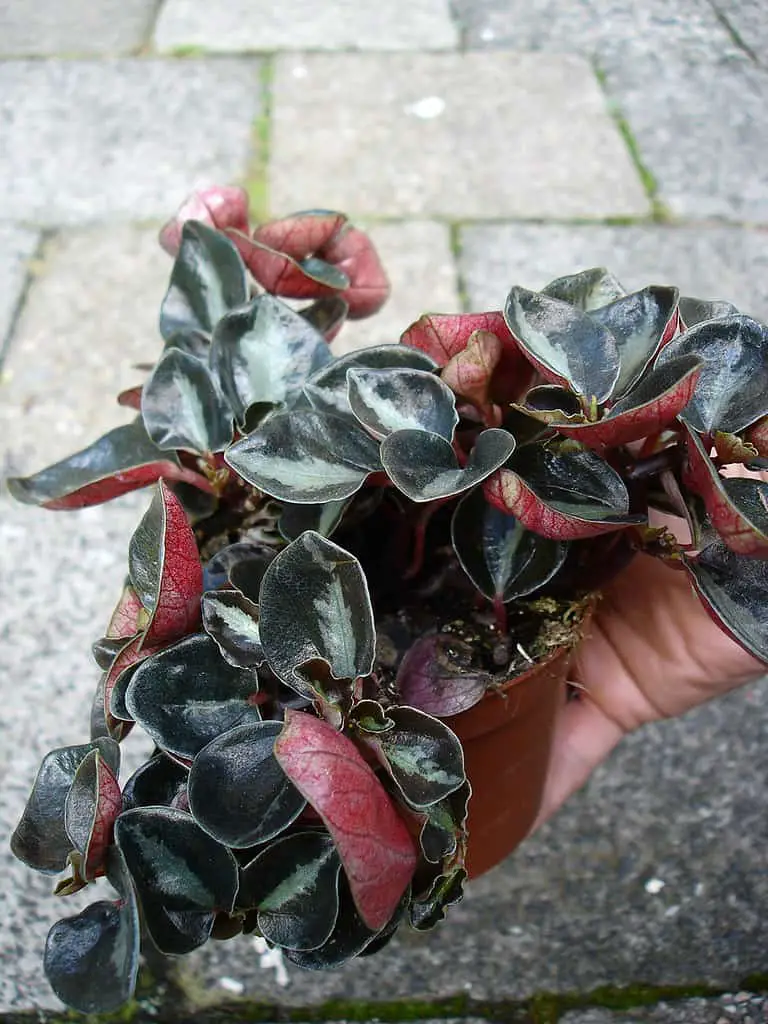
Peperomia metallica, which is commonly referred to as Columbian Peperomia, is known for its shiny, red leaves. It is a trailing plant with dark-colored leaves. While no plant can have truly black leaves, this plant’s dark burgundy leaves come very close! Peperomia metallica grows best in smaller pots as they like to be a little potbound. These plants will tolerate low-light conditions, but they should never be placed in direct sunlight as the leaves will burn.
If you like plants with dark-colored leaves, check out this blog post that discusses eight black succulents.
6. Beetle Peperomia (Peperomia quadrangularis)
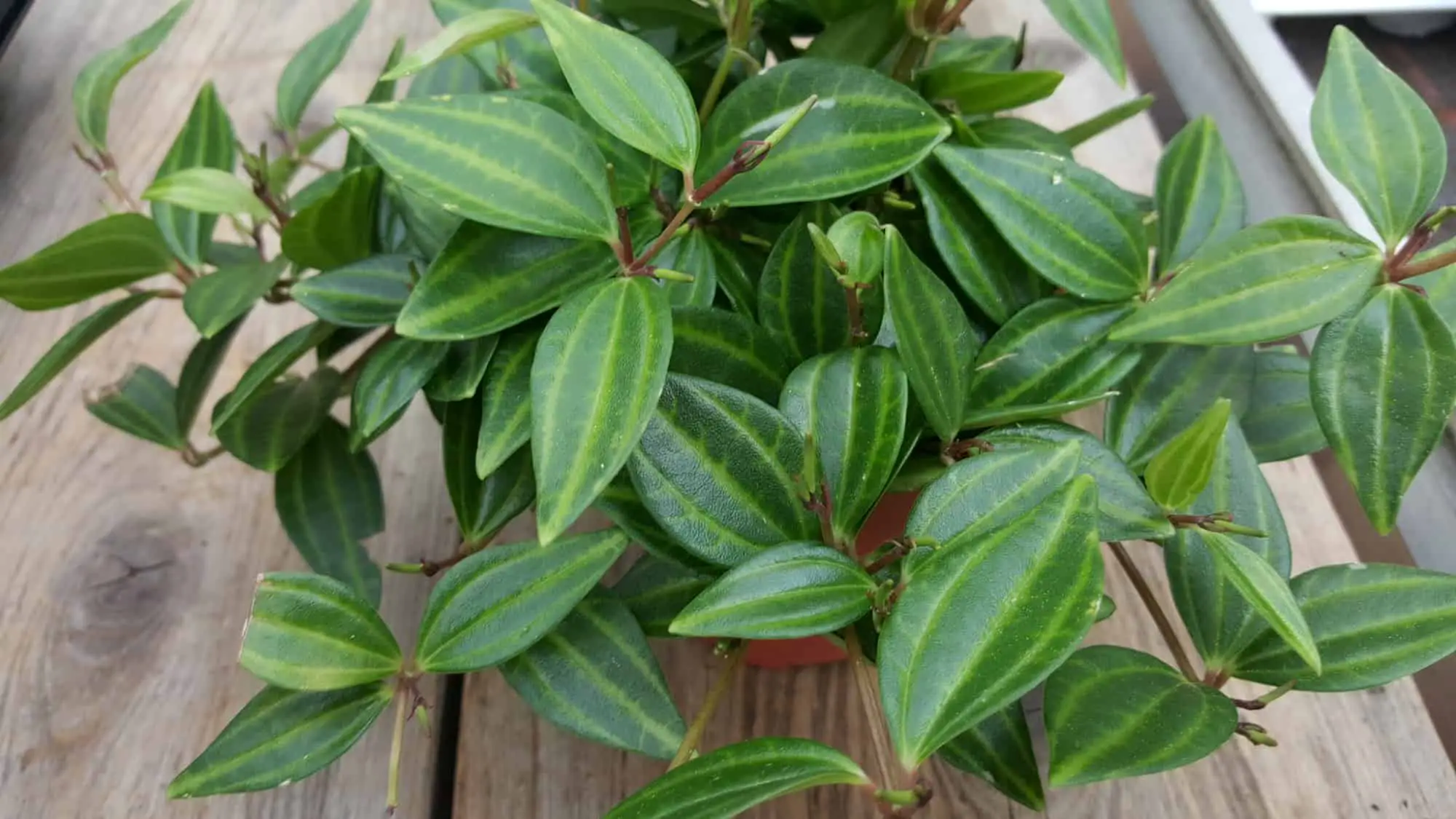
Beetle Peperomia belongs to the Piperaceae family and is native to Panama and Brazil. These plants will grow best in low and medium light. They look great in pots and terrariums. In high light conditions, the stems will turn a reddish color. Like other Peperomias, Beetle Peperomia can be propagated from leaf cuttings. Simply remove a large, healthy leaf with its petiole and place it in moist potting soil. Beetle Peperomia is considered a succulent, but it still prefers to grow in soil that stays moist all of the time.
7. Belly Button Peperomia (Peperomia verticillata)
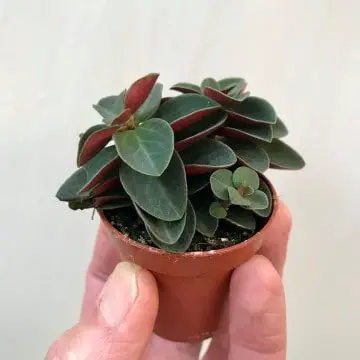
Peperomia verticillata, which is commonly known as Red Log or Belly Button Peperomia, is native to Bolivia. Their dark leaves and compact size make them a perfect desk plant. Belly Button Peperomia grows best in bright, indirect sunlight – ideally near a south or west-facing window. Unlike many of the other Peperomias on this list, Belly Button Peperomia can withstand some direct light. Allow the soil to dry out between watering sessions as this plant is very sensitive to overwatering. To avoid overwatering, put this plant in a pot with good drainage. Adding perlite to the soil mix will also improve drainage through the soil profile.
8. Baby Rubber Plant (Peperomia obtusifolia)
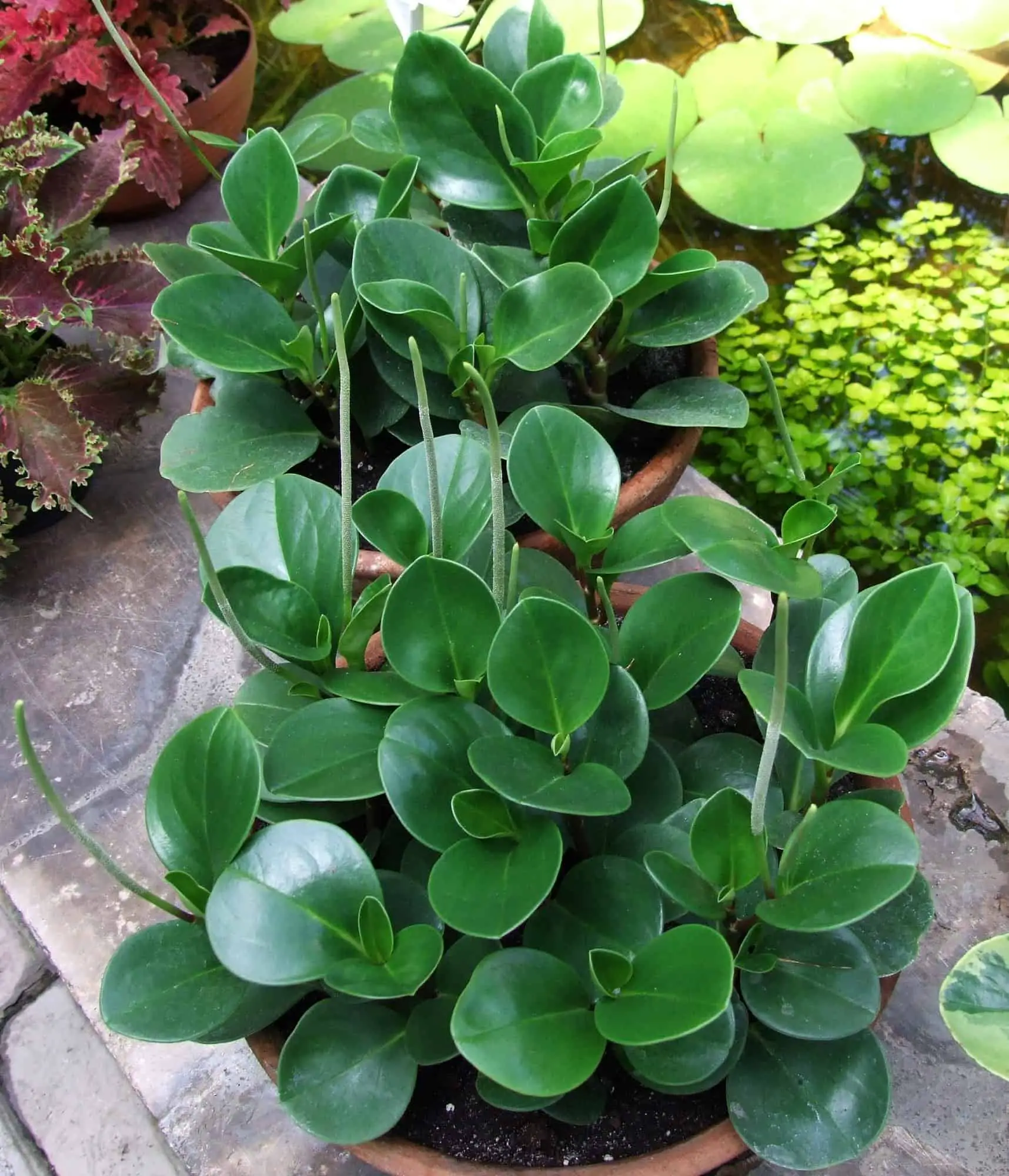
Peperomia obtusifolia, which is commonly known as Baby Rubber Plant or American Rubber Plant, is native to Southern Florida, Mexico, and the Caribbean. In the wild, this plant grows as an epiphyte rather than in soil. The name obtusifolia means blunt-leaved, and this plant is named for its round leaves. This plant is a succulent and holds water in the leaves. Baby Rubber Plant is sensitive to overwatering. To avoid overwatering, allow the top 3-4 inches of soil to dry completely between watering sessions. This plant does best in bright, indirect light, but it can grow in low-light conditions for several months. Peperomia obtusifolia has earned the Royal Horticultural Society’s Award of Garden Merit.
9. Felted Peperomia (Peperomia incana)
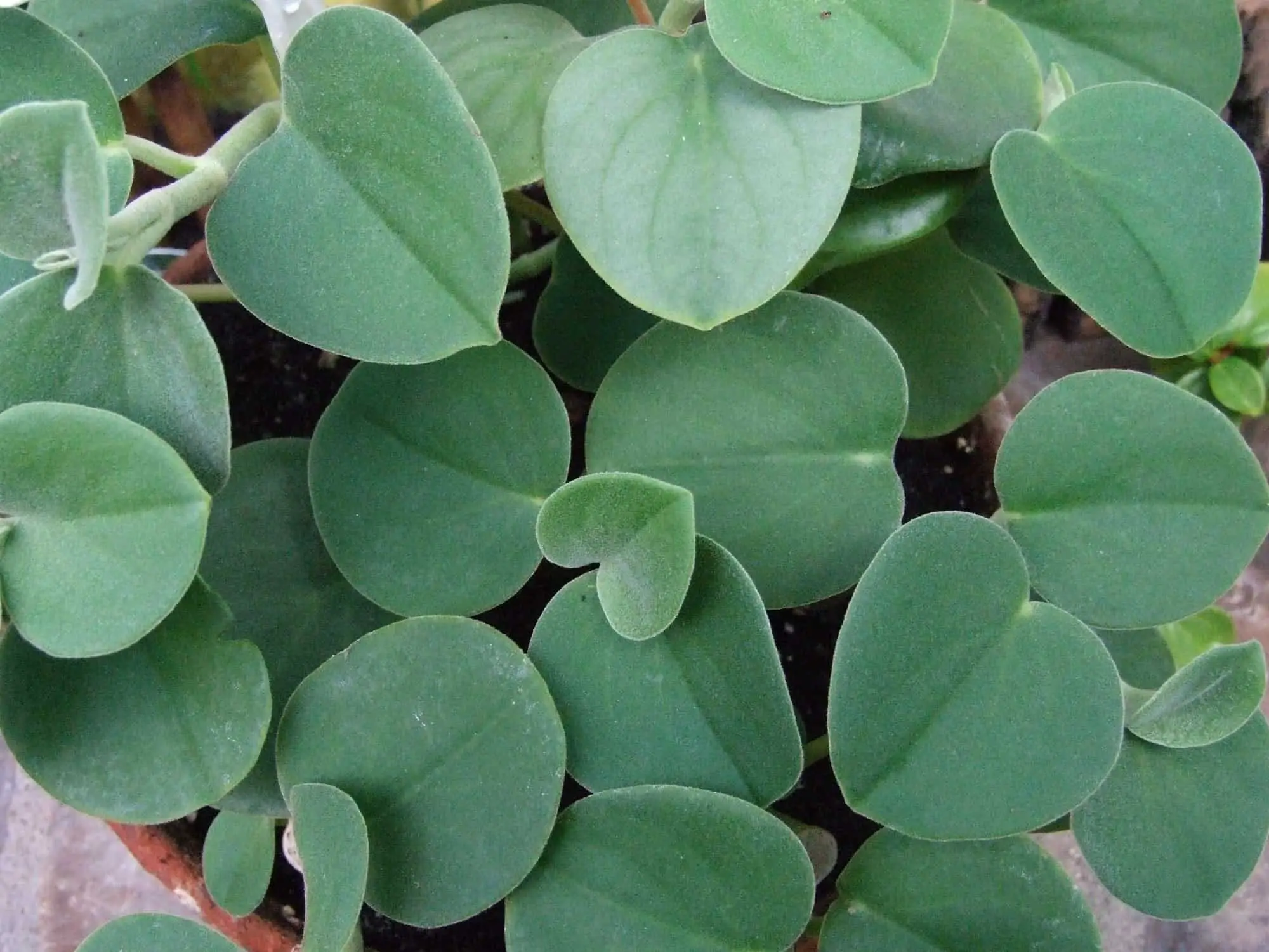
Peperomia incana, which is commonly referred to as Felted Peperomia, is native to Brazil. The blue-green leaves of this plant have a fuzzy texture and are soft to the touch. This plant grows to a maximum height of 6 to 12 inches, which is a bit larger than other species of Peperomia. Felted Peperomia can be grown outside in USDA Hardiness Zones 10 through 12 and has care requirements that are typical of Peperomias.
10. Peperomia serpens
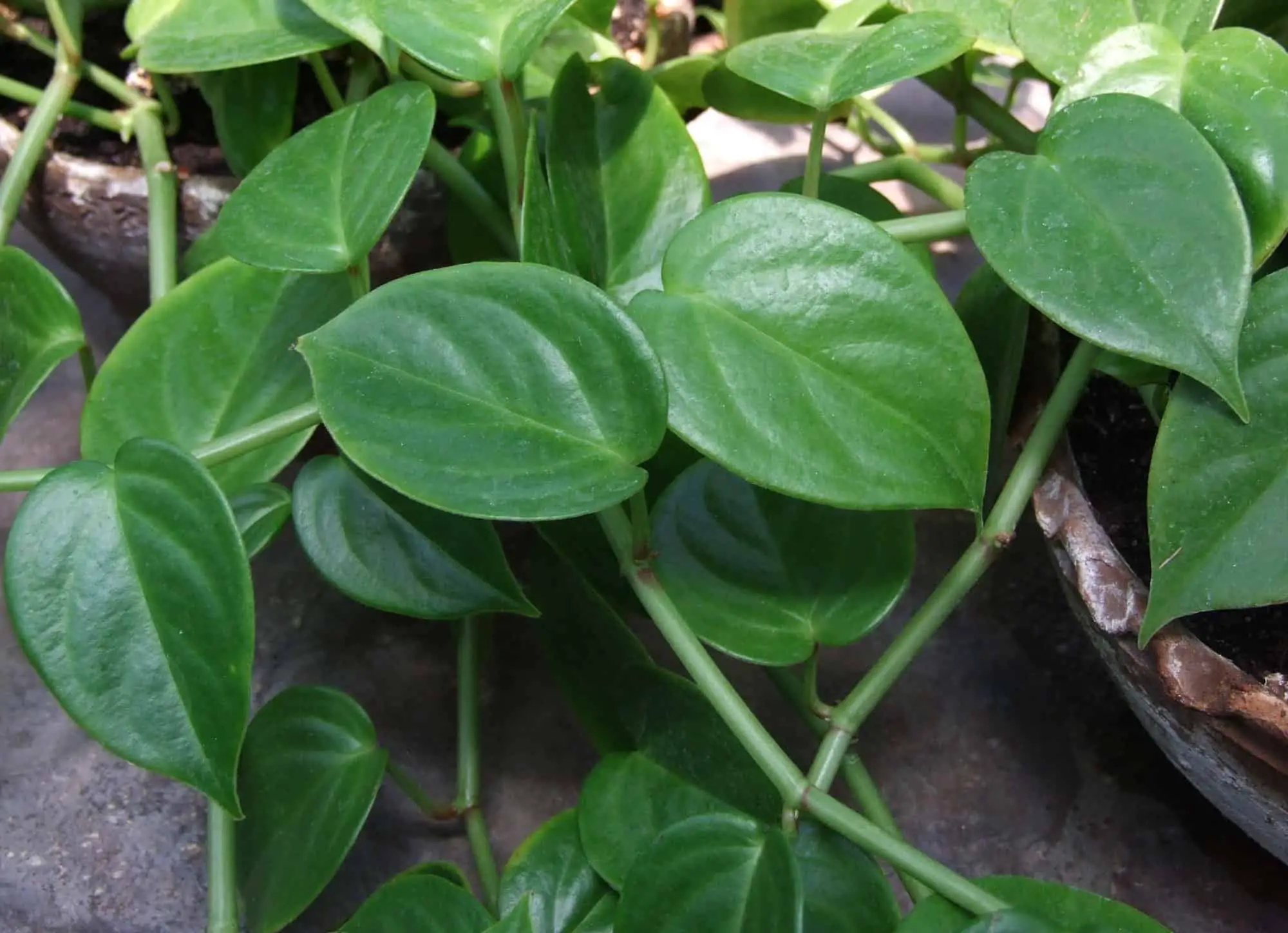
In its natural habitat, this plant grows under tree canopies. When finding a home for your Peperomia serpens, keep this in mind. These plants do best when grown near an east-facing window. Although this plant has succulent-like leaves, Peperomia serpens is not a succulent. Peperomia serpens has watering requirements that are very similar to other Peperomias. Allow the top 2-3 inches of soil to completely dry out between watering sessions. To avoid overwatering problems, keep this plant in a pot containing drainage holes. Like other Peperomias, this plant is propagated via leaf cuttings.
11. Peperomia rubella (Peperomia “Itsy Bitsy”)

Peperomia rubella is a beautiful, trailing plant with fuzzy leaves that is endemic to Jamaica. It is a fairly rare find and is not commonly sold in big box stores/nurseries. Peperomia rubella grows to a height of about four inches then sprawls out as a vine. This plant has smaller leaves than other species of Peperomia. This dwarf species grows well in terrariums and in containers. Like other Peperomias, Peperomia rubella does not grow well in direct sunlight. It does best in partial shade. As the plant is native to the rainforest, it does best in humid environments.
12. String of Turtles (Peperomia prostrata)
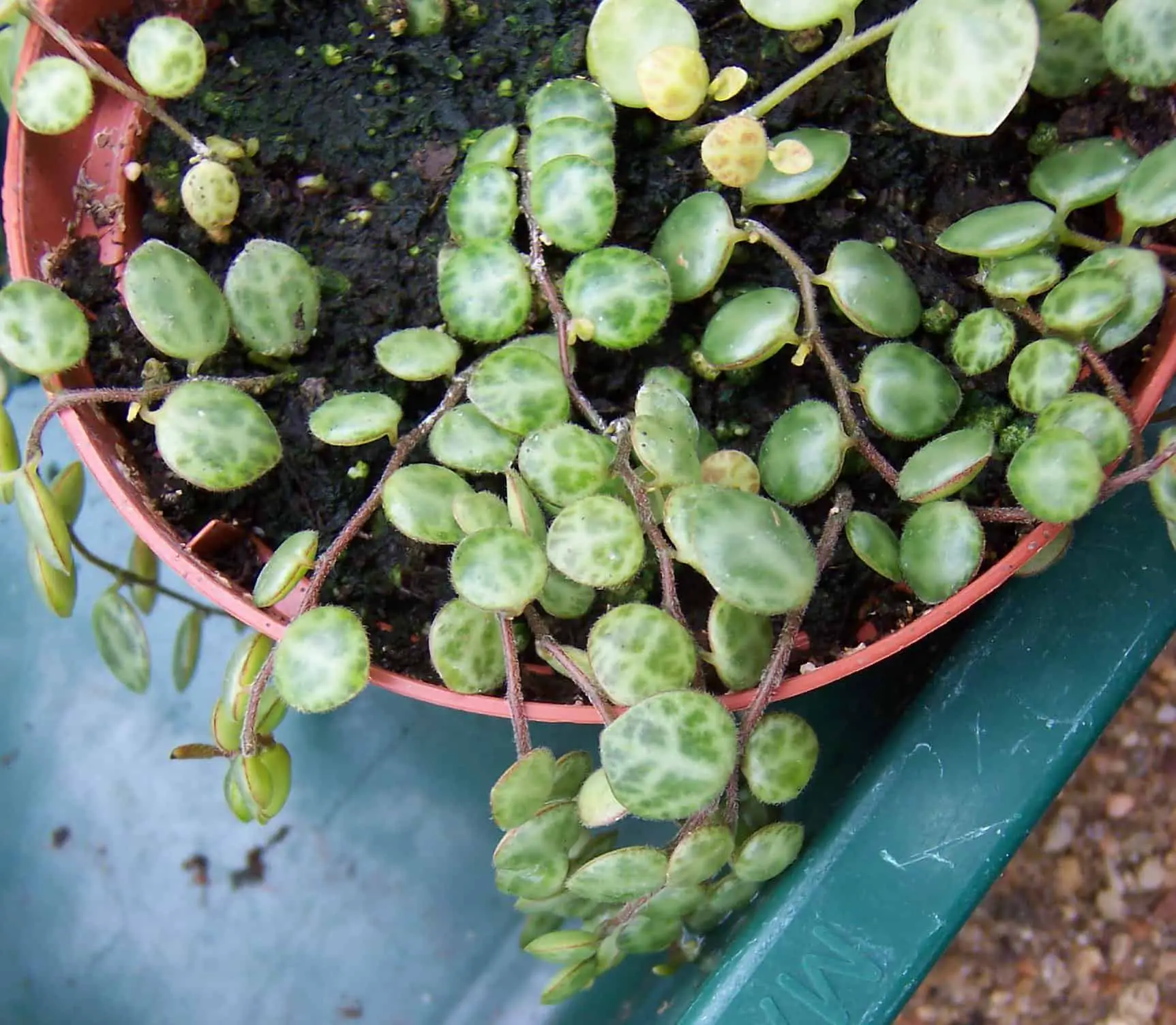
Peperomia prostrata, which is commonly known as String of Turtles, is another trailing plant that makes a beautiful houseplant and a great addition to terrariums. It is a succulent, so the leaves hold water. If you have had issues keeping String of Pearls alive, consider giving String of Turtles alive. The striking leaves are delicate and fall off of the plant quite easily, so it is best to put this plant in a spot where it won’t be bumped or moved. Peperomia prostrata does not require frequent watering. Mushy leaves are a sign of overwatering.
13. Peperomia japonica

Peperomia japonica is a trailing plant with green leaves and red or green stems. It has thicker leaves than most of the other plants belonging to the Peperomia genus. It can be grown outdoors in USDA Hardiness Zones 10 through 12. Peperomia japonica also makes a good houseplant and tolerates low-light conditions better than many other types of plants. If your Peperomia japonica becomes leggy (the space between the leaves increases), it needs more light. Interestingly, a study conducted by scientists at Hiroshima University found that Peperomia japonica extract is toxic to some types of roundworm and may be an effective antiparasitic agent (Nagashima et al., 2018).
14. Teardrop Peperomia (Peperomia orba)
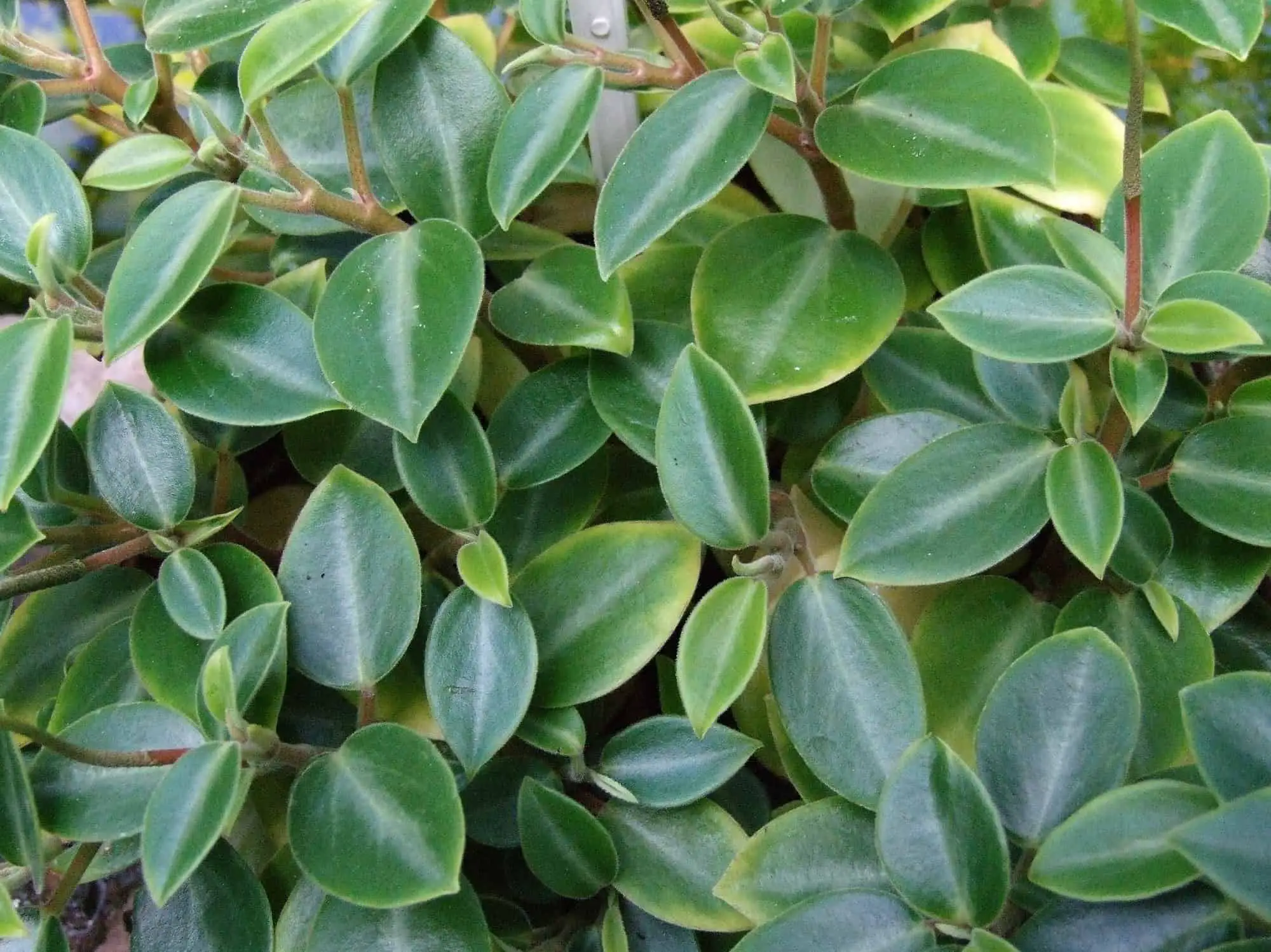
Peperomia orba, which is commonly known as Pixie Peperomia or Teardrop Peperomia, has small, round leaves that have a waxy appearance and is native to Central America. Some plants will have dark green leaves while others will have light green/lime green leaves. The lime green varieites will have some variegation throughout the leaves. Peperomia orba has lighting and watering requirements that are typical for Peperomias. This plant will grow well in window sills and tolerates low-light conditions.
15. Dwarf Watermelon Peperomia (Peperomia verschaffeltii)
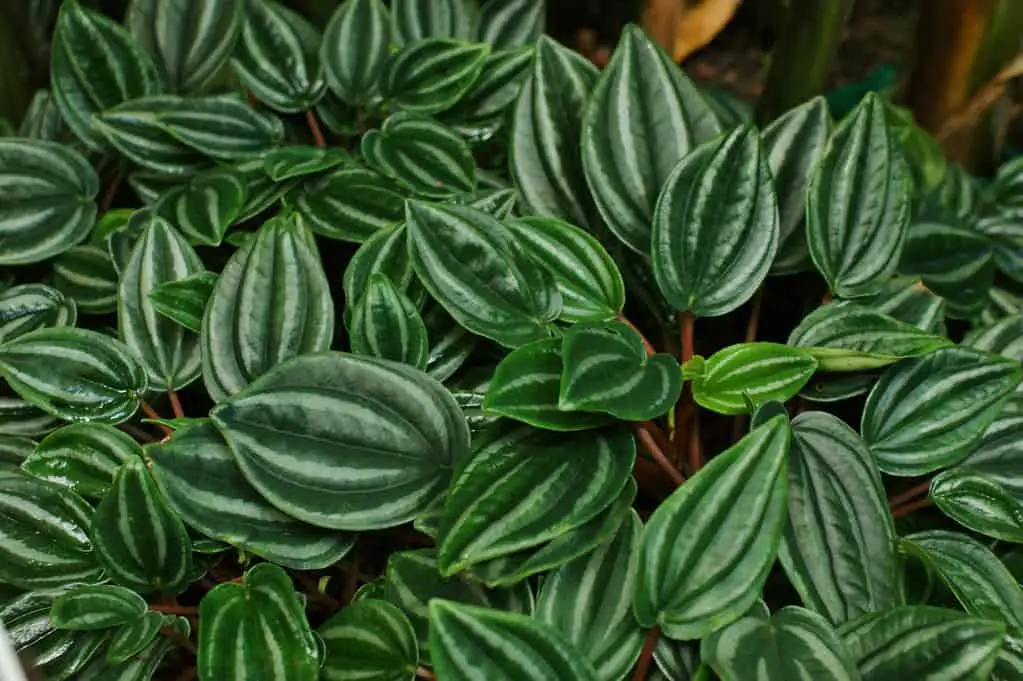
Peperomia verschaffeltii, which is commonly known as the Dwarf Watermelon Peperomia or Sweetheart Peperomia, is popular among houseplant collectors for the leaves’ silver and green “watermelon” patterns. The plant is native to Brazil and has watering needs typical of other types of Peperomia. Like many other types of Peperomia, this plant can thrive in a wide range of lighting conditions. However, the leaves may not be as vibrantly colored in low-light conditions. Similarly, too much light can cause the dark veins on the leaves to become less prominant. It is important to grow these plants in a porous, well-draining potting mix.
16. Peperomia rotundifolia
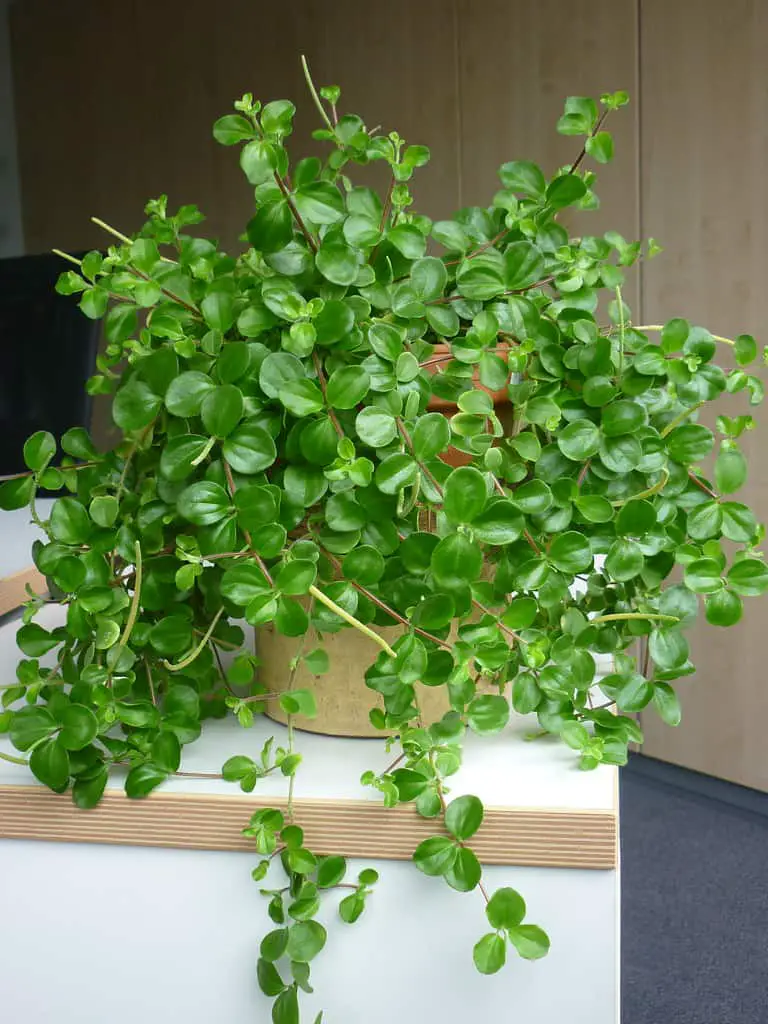
Peperomia rotundifolia, which is commonly referred to as Trailing Jade or Jade Necklace, is an epiphtyic plant native to the rainforests of South America. In the wild, they can be found growing in rock crevices and on trees. These plants can be grown in most homes and do well in small hanging baskets to encourage trailing. Peperomia rotundifolia does make a good houseplant, but it does require adequate humidity. To accomodate these needs, consider placing this plant near a plant humidifier. Unfortunately, these plants are somewhat difficult to find in stores.
17. Prayer Pepper (Peperomia dolabriformis)
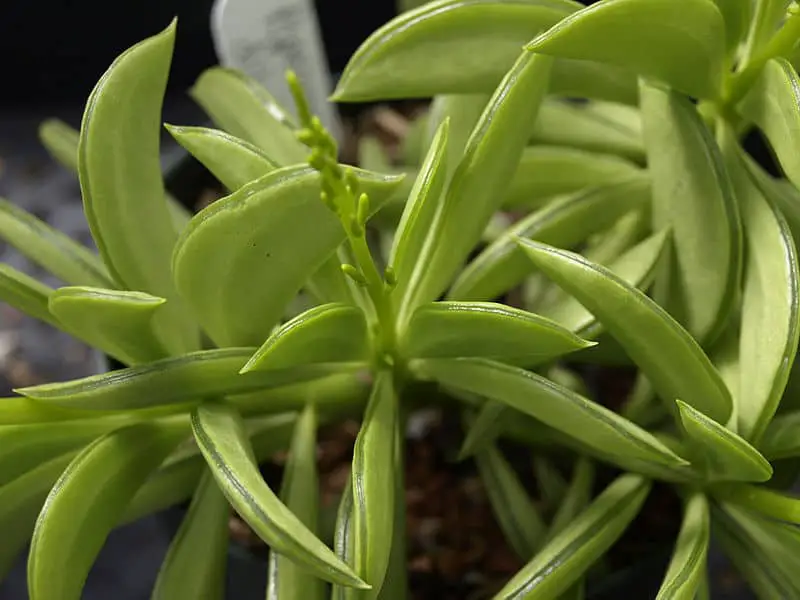
Peperomia dolabriformis, which is commonly referred to as Prayer Pepper or Prayer Peperomia, is a shrubby succulent with leaves shaped like pea pods. Peperomia dolabriformis is called Prayer Pepper because the light green leaves appear to be open in prayer due to a darker green semi-transparent center. The stem becomes woody with age. Prayer Pepper is native to the warm valleys of northern Peru and has water needs that are similar to other succulents.
Like many other types of succulents, Prayer Pepper is susceptible to mealybug infestations. If you see a white, cobweb type substance forming on the leaves of your plant, you may have a mealybug problem. Ants like to feed on the sweet, sticky substance produced by mealybugs and are often an indication of a mealybug problem.
18. Peperomia nivalis

Peperomia nivalis is a succulent that grows up to 6 inches tall and is native to the tropical rainforests of Peru. The thick, green leaves are often variegated and grow to a length between one and four inches. The fleshy stems produce anise-scented sap. Like other Peperomias, this plant thrives in bright, indirect light – ideally near a north or east-facing window. Like other succulents, the soak and dry method should be used to water Peperomia nivalis. This watering method involves watering the plant thoroughly and allowing the soil to dry completely between watering sessions. During the summer, the plant will produce a small flower that smells foul if you get close enough to the plant.
19. Cupid Peperomia (Peperomia scandens)
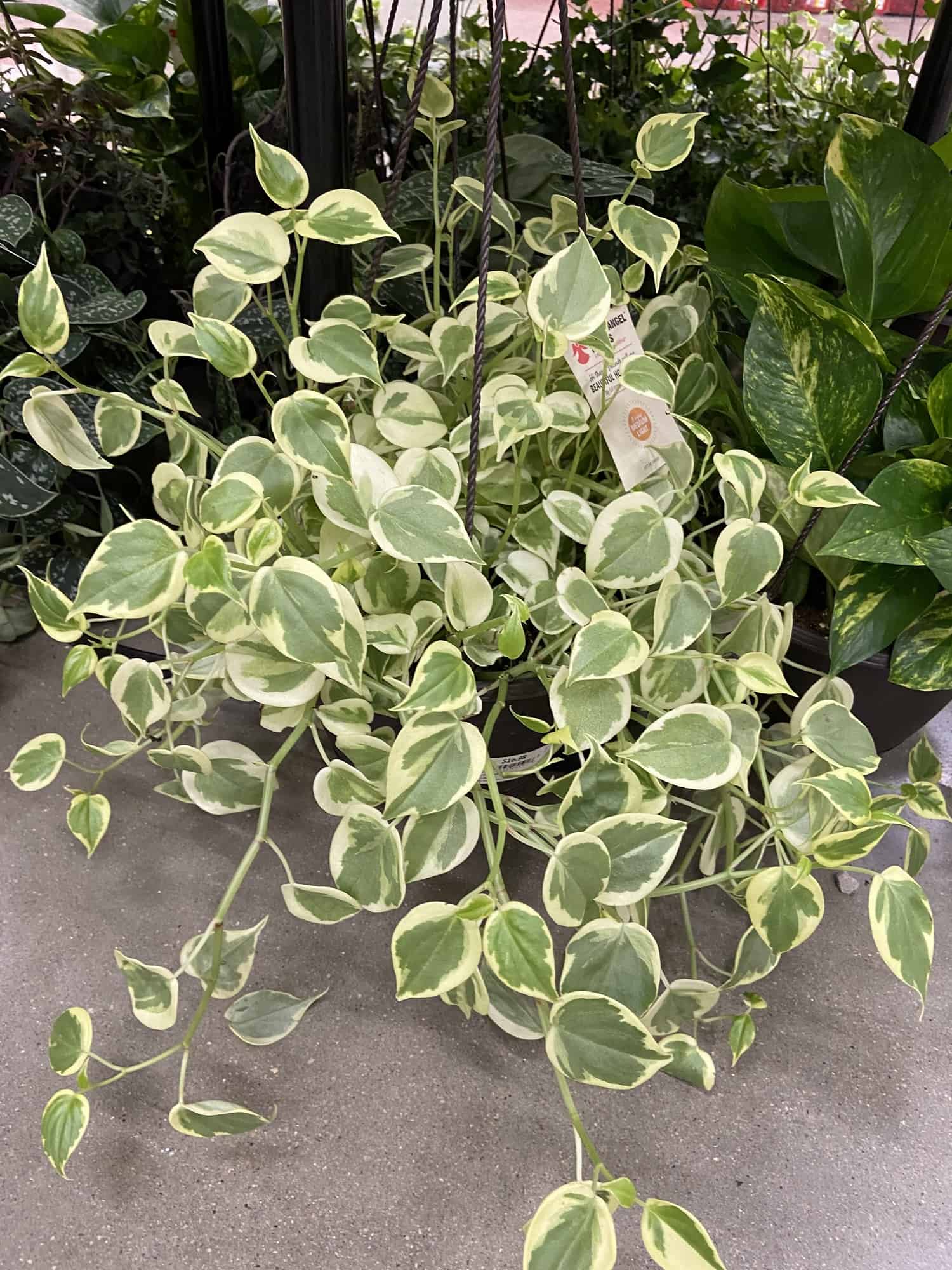
Peperomia scandens, which is commonly known as Cupid Peperomia or Piper Peperomia, is a gorgeous trailing plant with heart-shaped leaves. This plant is a vining, epiphytic plant native to Mexico and South America. Cupid Peperomia makes a good houseplant and has care requirements that are typical of Peperomias. This plant prefers partial light conditions and can be grown outdoors in USDA Hardiness Zones 10 and 11 as long as it is placed in the shade.
20. Peperomia puteolata
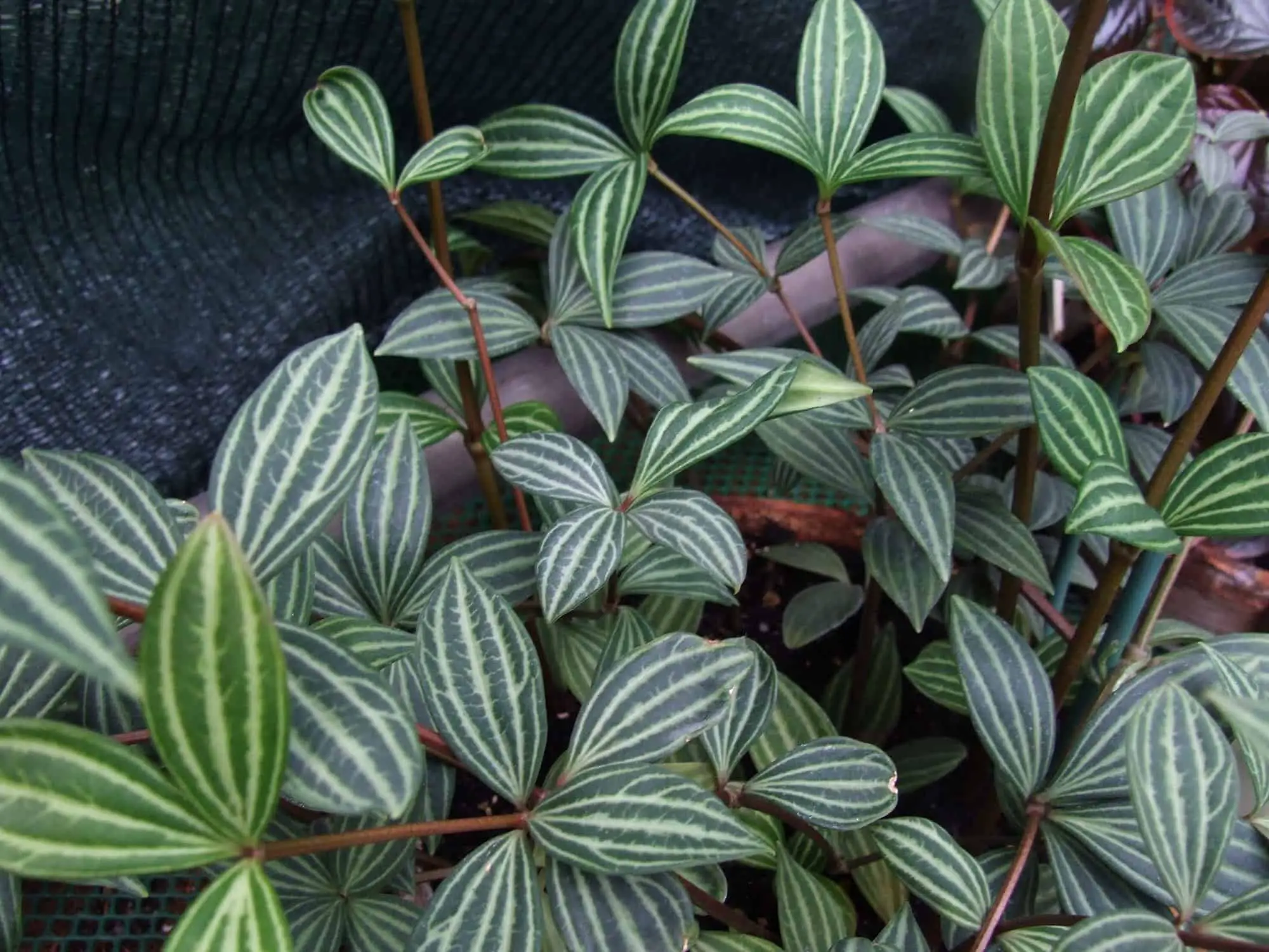
Peperomia puteolata is native to South America. In its natural habitat, it quickly spreads throughout the forest floor. It also makes a great houseplant and is suitable for houseplant beginners. Like the other plants on this list, Peperomia puteloata does best in bright, indirect light. Inadequate exposure to bright light can cause stunted growth. Peperomia puteloata can be propagated via leaf and stem cuttings.
21. Brazilian Peperomia (Peperomia urocarpa)
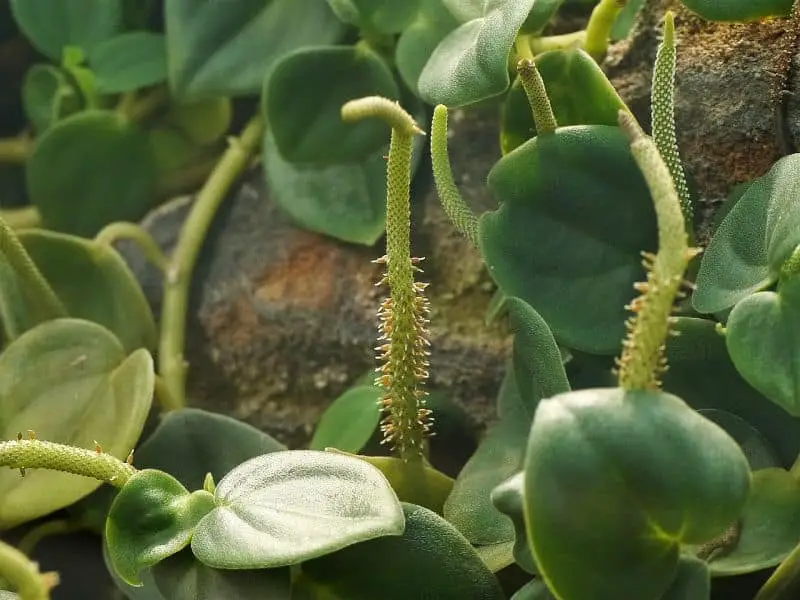
Peperomia urocarpa, which is commonly known as Brazilian Peperomia, is also known as Peperomia subpubistachya. Despite its name, Brazilian Peperomia can actually be found in many places including Colombia, Ecuador, Venezuela, Guyana, and Brazil. This plant is often confused with Peperomia pellucida, but Peperomia urocarpa has longer leaves.
22. Peperomia graveolens “Ruby Glow”
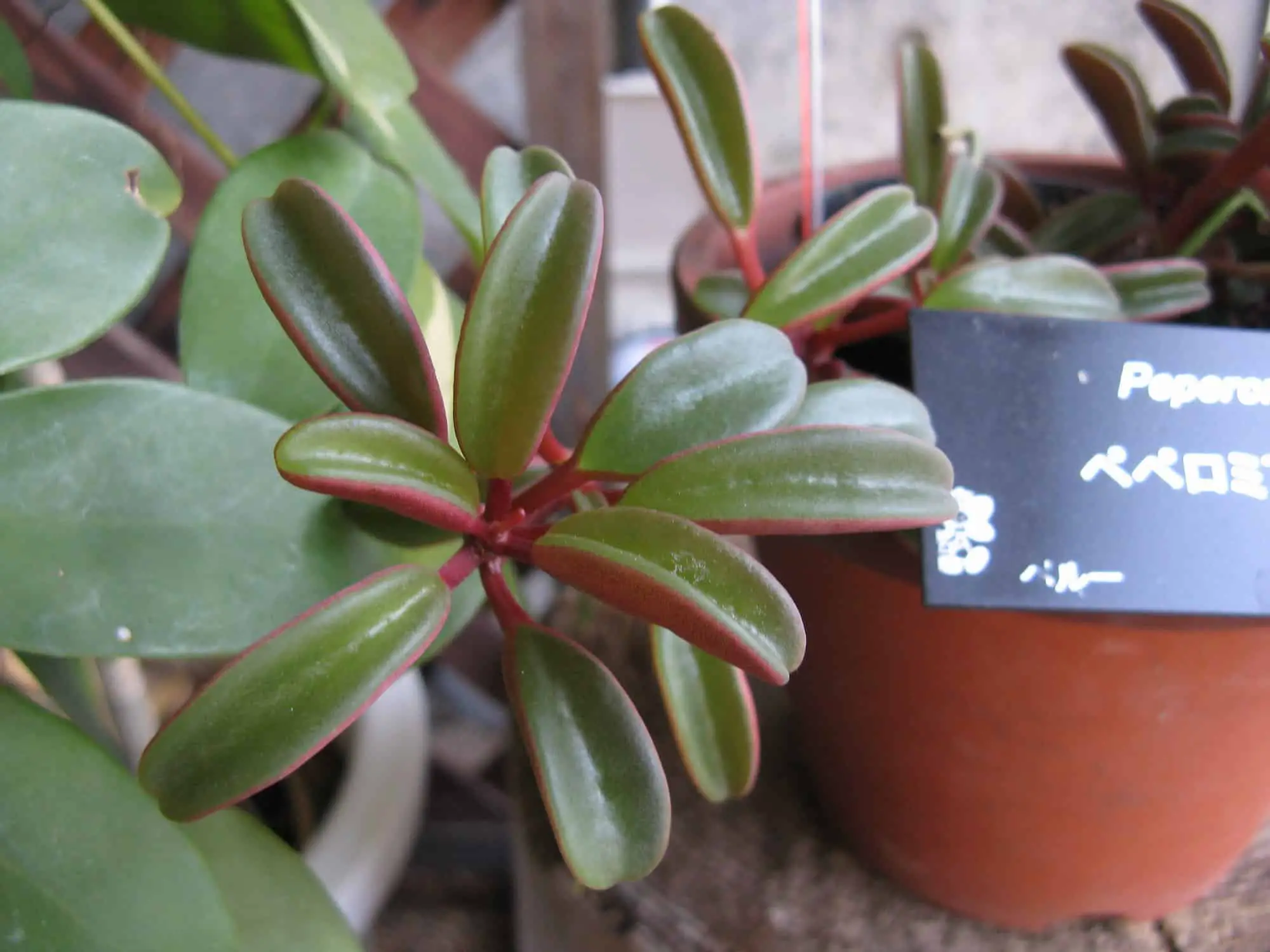
Peperomia graveolens “Ruby Glow” makes a great addition to desks and shelves. It is a good succulent for new plant parents and grows well in filtered light. Peperomia graveolens ‘Ruby Glow’ is native to the forest understories of the Ecuadorian forests. As such, it has adapted to low-light conditions. If you have had little success growing succulents in your home, I recommend giving these a try. These plants have watering needs that are typical of succulents. As such, the soak and dry method is an effective watering technique. This plant is adapted to a drier climate, so it is important to avoid overwatering. This plant also requires well-draining, so I recommend adding some perlite to your potting mix.
23. Piccolo Banda (Peperomia albovittata)
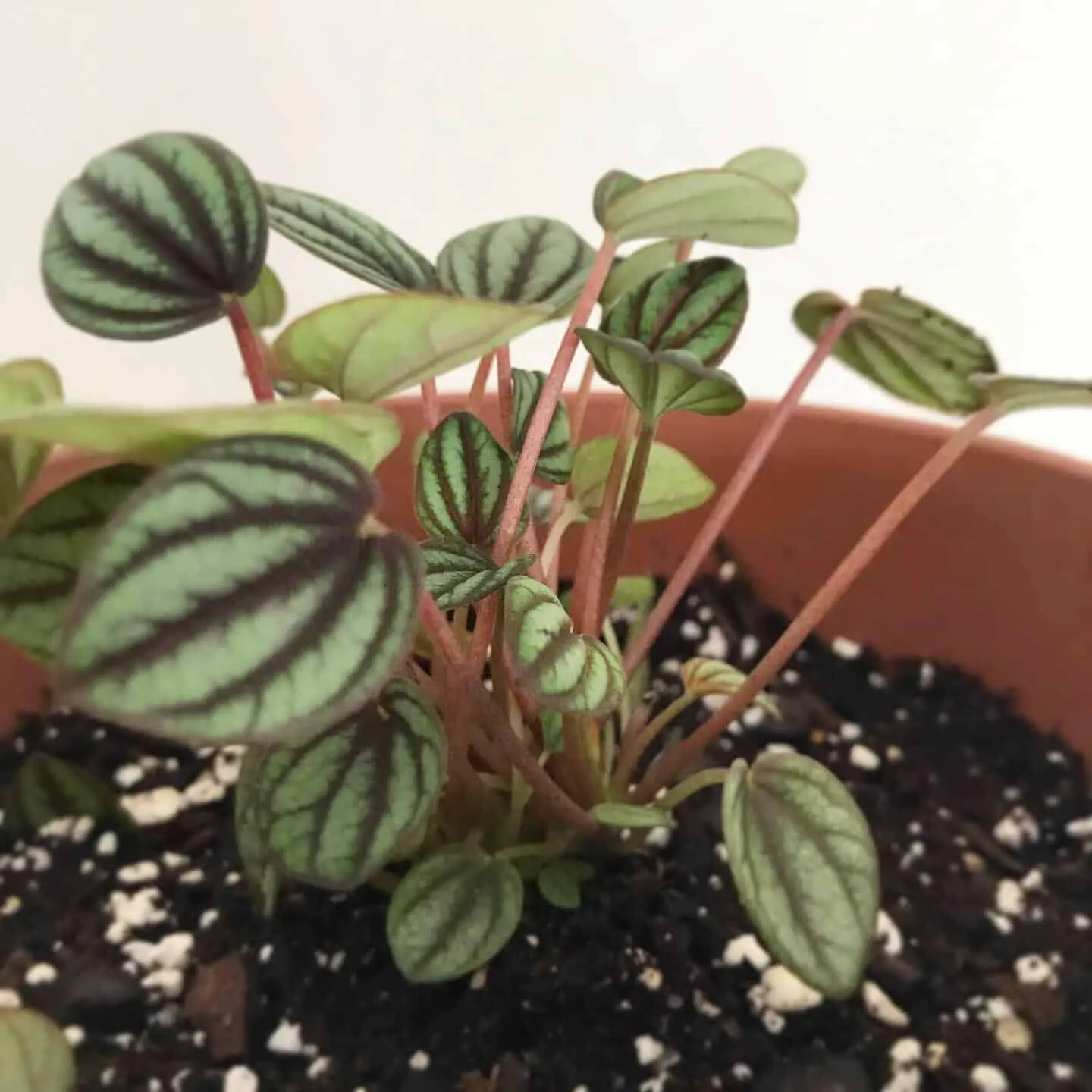
Peperomia albovittata, which is commonly known as Piccolo Banda, is a cultivar that was developed in the Netherlands. Like many of the other plants on this list, it is a popular houseplant, and the leaves look similar to the Watermelon Peperomia. It can tolerate direct sunlight during the morning hours and during the wintertime, but hot, direct sunlight can scorch the leaves. This species of Peperomia is semi-succulent. As a result, the top few inches of soil should be allowed to dry out between watering sessions. Like other Peperomias, Piccolo Banda can be propagated via leaf and stem cuttings. It takes about eight weeks for this plant to root.
24. Peperomia “Fuzzy Mystery”
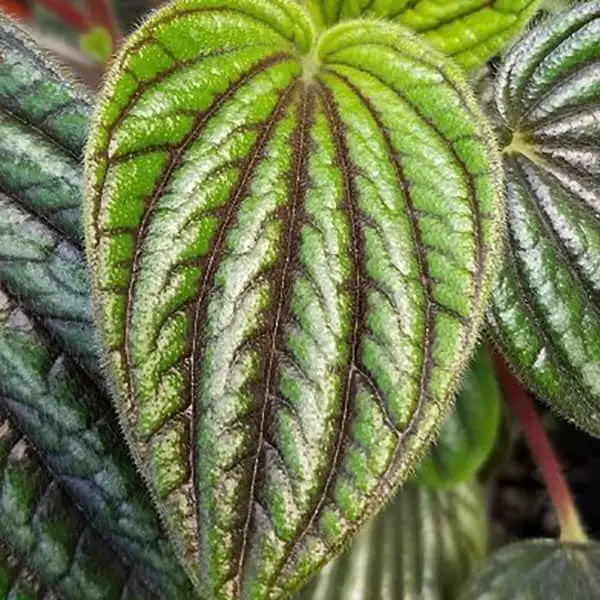
Peperomia “Fuzzy Mystery” is an unnamed type of Peperomia that has become increasingly popular. As you may guess from the name, the leaves have a soft, fuzzy texture. The coloring of the leaves is similar to other types of Peperomia. There are several online retailers that sell this plant.
25. Peperomia axillaris
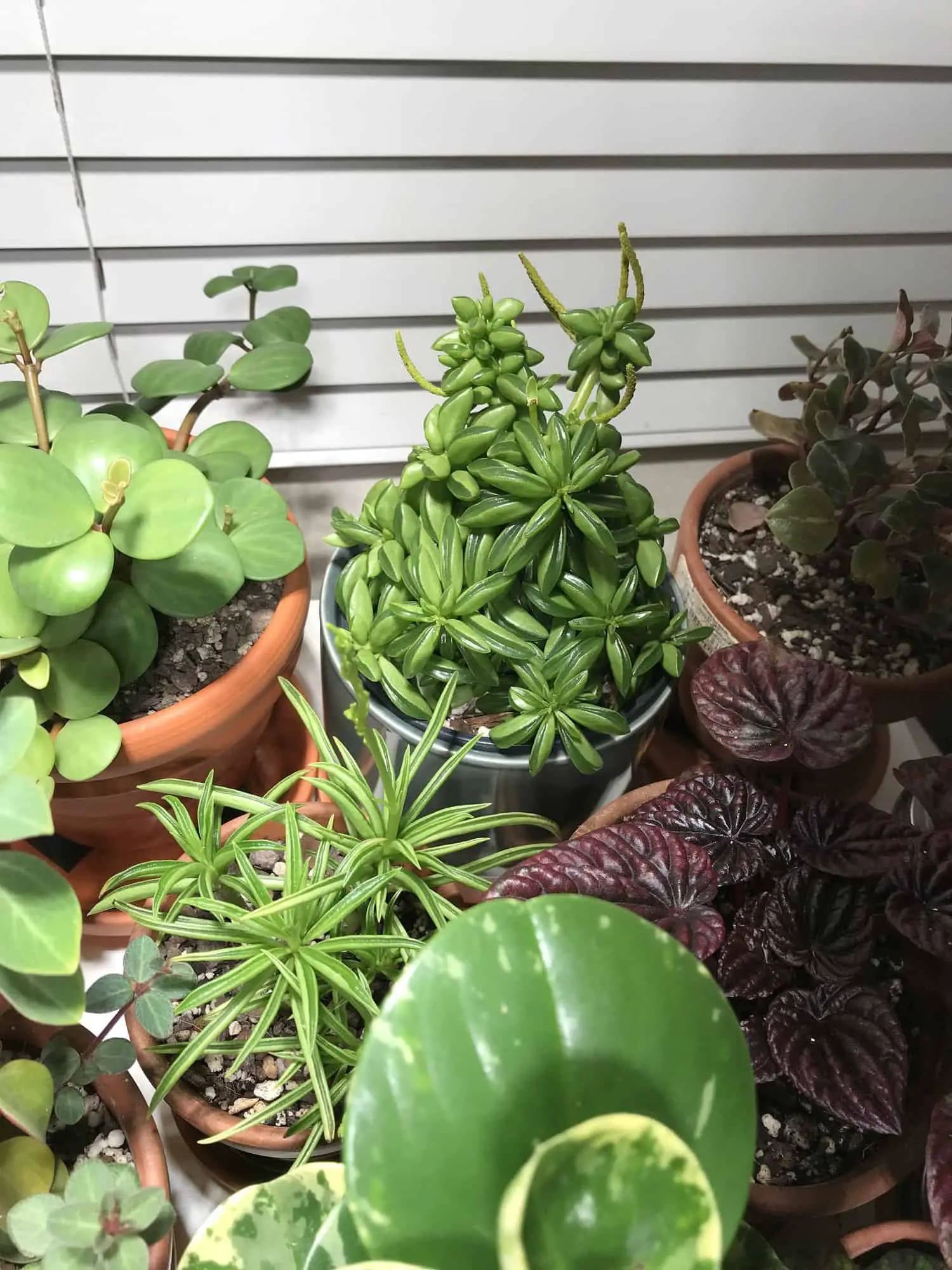
Peperomia axillaris is comprised of leaves shaped like pea pods. Like other succulent species, these plants should be watered using the soak and dry method. Peperomia axillaris needs to be exposed to plenty of bright, indirect sunlight to survive. However, they can withstand lower light than some other types of succulents. This succulent is somewhat of a rare find, but it is a great plant for beginners!
